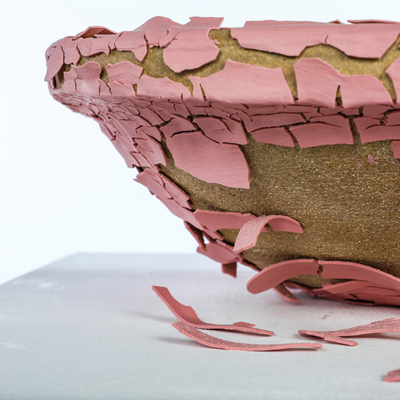2020 AWARD WINNER | Cardiff School of Art & Design
Posted on - 9th September 2020

Nathan Barnard | BA Hons Ceramics
Cardiff School of Art & Design (CSAD)
Tell us about yourself, your work, and your career path so far.
I was born in Stevenage, and have since moved around the UK, being in a different county every few years or so. It’s a cliche, but I’ve always been creative, learning to play instruments from a young age as well as making mud pies and of course the sorts of paintings that parents hang on the fridge. After doing my foundation in 2016-17, I moved to Cardiff to start my degree in Ceramics at CSAD. Now that I’ve graduated, I’ve decided to stay in Cardiff as it’s a great city for artists and I’m starting a year-long residency at Fireworks Clay Studios in November.
My work is centred around Phenomenology and sensory experiences and exploration. I am first and foremost concerned with ‘the joy of making’. I found it very hard in my first year to feel comfortable with making and felt tunnelled into a certain way of working. This was only due to my own expectations but having since let go of these, I am much relaxed and make things that make me happy. My experimentation with glazes has also come from this, but Phenomenology has been the underlying focus for my work, to create objects and textures that lead the viewer to think of their personal emotions in response to my work.
Describe your first encounter with clay?
Though not clay, as a kid, I was always making mud pies or digging about in the garden. I also had a LOT of play dough at home and at nursery, making crazy shapes with the plastic extruder or giving little heads bright green hair etc. However, my first encounter with clay itself was in my third primary school. We were studying the Greeks for History and were lucky enough to have a wheel and a guest potter come in and help us throw wonky earthenware vessels which we then painted with some dodgy Greek-style motifs. Despite this, Ceramics was never really a massive part of my life until my late teens. A friend of mine (now doing Ceramic Design at UAL) suggested I go with her to a 6-week course for beginners in Ceramics at Gateway Education & Arts Centre in Shrewsbury. I did just that and, despite being pretty bad, enjoyed it so much that I knew some kind of artistic career path was the one for me.
Why did you choose ceramics?
As I’ve mentioned, Ceramics didn’t come naturally to me and I only felt like it was the right thing for me in my late-teens. Following the 6-week courses I attended, I dropped out of my A-Levels and applied for a Foundation in Art and Design in Wrexham. There, my tutor, Marcus and I connected through ceramics as he had done his MA in Ceramics at CSAD around the same time as Duncan Ayscough (now of our lecturers at CSAD). I was also highly interested in textiles and was granted almost sole use of the industrial weaving loom and knitting machine there. I was set on going into textiles at Uni and changed my mind at the last minute following several talks with Marcus. He got me into the ceramics studio in Wrexham and once I touched clay again, I knew I wanted to learn everything possibly could about it. Following my interview at Cardiff Met, I realised that it was definitely the right choice and having graduated now, I’m very glad I chose Ceramics.
Where do you find inspiration? Places, people, objects, music...
Honestly, everywhere, in everything. I’m constantly looking, taking pictures, scribbling things down or making notes on my phone to go back to things. Texture is on of my biggest inspirations and often when I go out I’m taking pictures of the floor, of tree trunks, walls, water, mud etc. more so than anything else. Food is also a big influence for me, the colours, textures, scents and tastes all play into this very stimulating experience. But the visual element of how food looks on the plate, often with similar or complimentary colours is what I look for the most. Working in a kitchen this is pretty easy to take note of and, although I don’t try and recreate a barbecued lamb rib in my work, I am constantly striving for those visual elements that keep you looking and intrigued. Lastly, Splott Beach in Cardiff is a fantastic place to find a very strange accumulation of textures and colours. From washed up pebbles to dumped rubbish, there’s always something that catches my attention there and I’m known to come away with some peculiar piles of things from Splott whenever I visit.
What are the tools of your trade that you can't do without?
My favourite ‘traditional’ ceramics tools to use are metal kidneys, both serrated and not, a surform and of course a needle tool. However, I’m also very found of cutlery as tools. Forks are great for removing batts from the wheel and creating scratches for joining; spoons are fantastic for carving & smoothing and knives are good for adding slip to pieces or marking where you need to cut a piece when you can’t find your needle tool. Especially whilst at uni, with the amount of cutlery running amok in the studio it was very easy to replace a tool should you lose one. Despite that, though, a MudTools Surform is my most favoured tool. It’s brilliant for trimming pieces on the wheel, adding texture to work, making a good surface for joining and helping to see unwanted undulations in a flat piece.
What is a typical day in the studio like?
I tend to have a slow start in the morning, where I get myself set up with a list of what I need to do over a cup of tea and breakfast. Then, I can get to work. I usually start with a rough sketch or have an idea in my head of what form I want the piece to take. This isn’t set in stone though as I allow the process of making to determine the outcome of a piece. I try to work on several things at a time in order to use my time in the studio wisely but this doesn’t always go to plan. Especially when I’m stressed I can get quite stuck and not know what to do next, which is where the lists come in handy. Throughout the day, between making, I’m usually researching glazes or putting together a bank of images that inspire my making and thoughts. To those looking in on a typical day of mine, it might look a little chaotic but I always have a plan in my head and know the direction I’m going in. Plus, I work best doing lots of things at the same time as I don’t want to become stuck on perfecting one piece at a time.
What do the next 12 months have in store for you?
I recently found out that I have been given one of two spaces at Fireworks Clay Studios in Cardiff for a year-long residency, starting in November. Whilst I’m there I intend to expand on the work I was doing at the end of my degree, with more glaze experimentation in order to make my work less fragile, so that those with visual impairments can have a tactile sensorial experience rather than a purely visual one which is what my work is currently. November is a few months away though, so in the mean time I’m going to be doing a lot of reading, drawing and digital 3d modelling so that when I start at Fireworks I can jump straight into making with a strong basis beneath me.
What advice do you have for those currently studying ceramics in further education?
Don’t take time in the studio for granted. Despite trying to keep myself to a schedule it always went to pot in the studio, getting distracted quite easily. But if the situation from Covid-19 has taught me anything, it’s that time in the studio is precious. Especially with many universities giving access at specific times in the upcoming academic year, it’s going to be vital that the time you have is spent well. But more importantly than that, just have fun. Enjoy what you’re making and don’t get too caught up on it being completely perfect. Not everything you make is going to be fantastic but as a student, you have time to practice and get to where you want to be. It’s so much more enjoyable to make what you want to make and practice what you want to practice. The fun you have with it, the less stressed and the less stuck you’ll be. Good luck!

